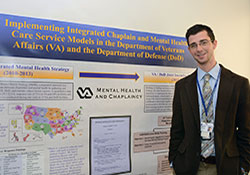Office of Research & Development |
 |
Office of Research & Development |
 |

VA Research Currents archive
Posted November 20, 2013
The Rev. Austin Ochu knows a little something about trauma. Before coming to VA, the Roman Catholic chaplain worked with Liberian refugees in the Ivory Coast in West Africa, so on a recent day at the Baltimore VA Medical Center, when an Afghanistan Veteran mentioned suicide, Ochu knew exactly what to do. "I listened to his story. We talked about guilt, fear, forgiveness, and lack of hope, and when we were done, he promised to come see me again."
Ochu is part of a growing movement in VA and the Department of Defense (DoD) to integrate spirituality with mental health care, as discussed in an April 2013 report in the Journal of Health Care Chaplaincy coauthored by Dr. Keith Meador, director of VA Mental Health and Chaplaincy, with colleague Dr. Jason Nieuwsma and others.
While chaplains have long served the needs of service members and Veterans, they are increasingly being seen as important to providing integrated mental health care services. Part of this is due to the unique role chaplains play in a service member's life. "People don't go straight to their psychiatrist," says Ochu, who meets several times per week with his peers on the mental health side to workshop ways they can better assist Veterans. "They go to their church first."
That, according to Meador, is one reason why chaplains must be integrated into overall mental health care. "The reality is chaplains are inevitably looked to as first line providers with regard to mental health issues," says Meador, who is based at the Durham VA Medical Center "Chaplains are trusted. Even if they [Veterans] are not particularly religious, they see the chaplain as someone they can talk to—yet historically the two [mental health and chaplaincy] have not worked together."
Meador points to research identifying a link between spirituality and mental health. For example, studies have shown that many of the struggles Veterans experience with posttraumatic stress disorder are worsened by difficulty with forgiveness and spiritual beliefs. Based on data from that and many other studies, VA and DoD launched the VA/DoD Integrated Mental Health Strategy (IMHS) in 2010. A key component focused on the need for collaboration between chaplains and mental health providers. As part of the IMHS, Meador and his colleagues conducted site visits to 33 VA or DoD facilities over a two-year period, collected more than 2,000 surveys from chaplains, hosted expert forums, and developed a task group of leaders and experts in the fields of chaplaincy and mental health.
The researchers found that although chaplains were extensively involved in mental health care, they were limited in their effectiveness as a result of training, location, and a lack of understanding and cooperation between chaplains and mental health professionals.

Dr. Jason Nieuwsma, associate director of VA Mental Health and Chaplaincy, has been helping to spearhead research on integrating the two fields. (Photo by Linnie Skidmore)
As a result of the IMHS study, Meador and his colleagues developed a model to integrate chaplains into overall VA mental health care. The first step is training. Despite the fact that chaplains are often on the front lines of mental health care and are well-educated, Meador and Nieuwsma research identified gaps in how chaplains viewed their training. They reported not feeling optimally prepared to deal with anxiety, depression, and other common mental health issues, despite the fact that those are the issues they are overwhelmingly faced with. "We want to better equip them to meet the needs that they clearly are encountering without taking away from that traditional chaplain role," says Meador.
Similarly mental health professionals often reported not knowing how to use the chaplains they worked alongside. "Although we encountered a number of mental health professionals who knew little about chaplaincy, by the end of a day-long site visit we frequently saw that the two disciplines were having ideas about how they could work together," says Dr. Jason Nieuwsma, associate director of VA Mental Health and Chaplaincy. Researchers hope joint training, webinars, and systems redesign efforts increased interaction can continue where those site visits left off.
In addition to training, researchers proposed having teams of chaplains and mental health experts develop integrated tools and plans for bridging the gap between clergy and mental health professionals. The idea of working together highlighted another major barrier: location. Chaplains and mental health workers should be located together, Meador says, and that is not normally the case.
The end goal is to develop integrated teams to care for all of a patient's needs. "A person is both body and spirit," says Ochu. "Just as you treat someone's physical needs, you must also worry about their spirit. That is what patient-centered care is about and that is what we do here at VA."
Although the study was unprecedented, there were limitations. Researchers didn't have the time or capacity to solicit information from Veterans and service members or to garner more input from mental health professionals. Meador and Nieuwsma's integration model also remains untested and will likely need to be refined before it can fully function. Also, they anticipate some natural resistance from the mental health community to the integration plan.
Challenges notwithstanding, Meador remains optimistic. "VA and DoD are leading in this. Incorporating chaplains and clergymen into health care will be a major asset, not just for the VA, but across the healthcare spectrum. These are good changes."